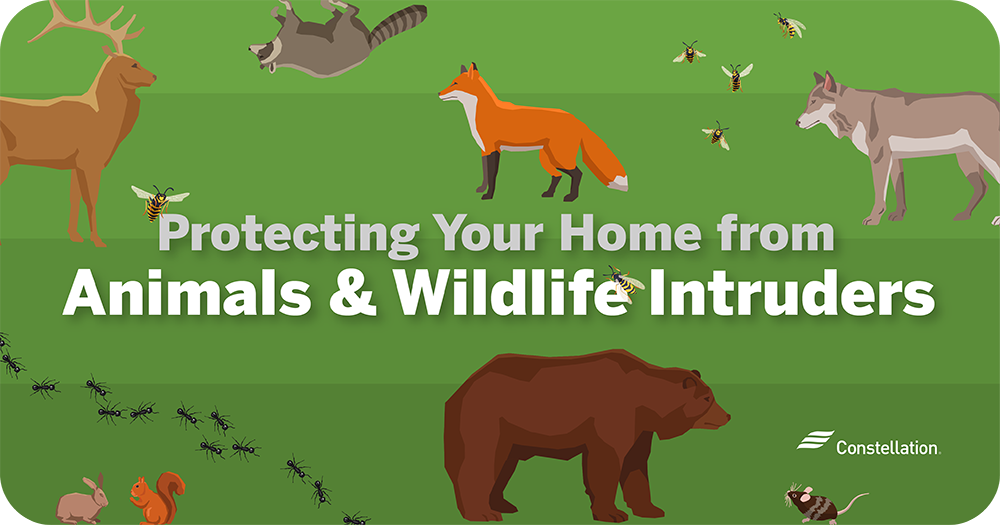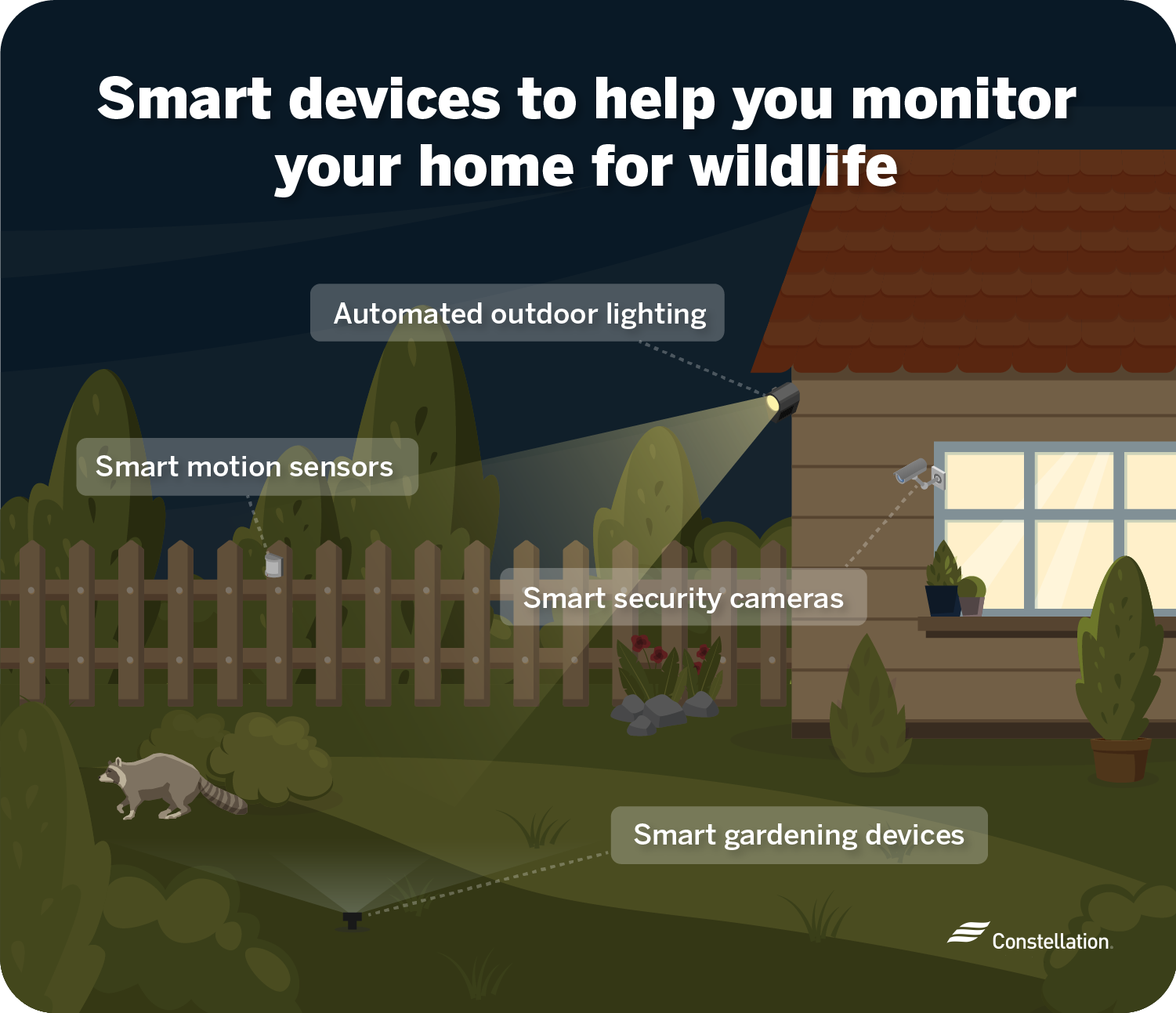
- Category:
Home Energy Savings - Published:
November 12, 2021 - Updated:
February 22, 2022
Protecting Your Home from Animals & Wildlife Intruders
It’s common to wonder how to protect your home from wildlife. People in suburban areas are dealing with more wildlife around their homes as development expands into formerly rural areas. Wildlife are adapting to the presence of humans, increasingly moving into urban areas as their traditional ranges get squeezed.
While resurging wildlife is a good thing, wild animals put your garden, pets and home at risk. Striking a balance between being sensitive to the needs of wildlife and the wellbeing of your property and family is challenging.
What are the most common wildlife intruders?
Depending on where you live, the kinds of wildlife to manage varies. Rodents and insects are the most common pest animals, however large game like deer and the predators that hunt them can create a dangerous situation.
The animals below are some you will want to keep an eye on so you can figure out how to keep animals out of your yard.
- Squirrels. These rodents can chew their way into your attic or basement, bringing in insects and destroying property.
- Rats. They spread disease and damage property, having plagued humans for thousands of years.
- Rabbits. Cute little bunnies can quickly destroy your garden and create dangerous holes in your yard. Plus they bring in predators.
- Deer. In addition to eating your garden, deer carry the kind of ticks that spread Lyme disease.
- Raccoons. As carriers of rabies, these rodents are a health hazard. And they will make a mess in your garbage.
- Opossums. These animals can spread dangerous diseases and can be aggressive when confronted.
- Bears. Once rare, bears are making inroads into the suburbs. They may attack pets or even you, but the greater danger is damage to your property as they break into your home in search of food.
- Coyotes. As with bears, these members of the canine family are increasingly seen in settled areas. They will attack and kill pets.
- Ants. Some are just a nuisance, but others can do as much structural damage to your property as termites.
- Wasps, bees and yellow jackets. A random sting is unpleasant, but when these insects swarm, they can inflict life-threatening harm on people and pets.
What kind of damage can wild animals cause to your property?
Wildlife can be beautiful, and animals and insects certainly have as much right to living space as we do. Still, they can do significant damage. You’ll want to monitor their activities so that you can plan ways to protect your home from wildlife. Preventing wildlife damage is an important part of keeping your smart home secure.
- Insulation damage. Many rodents will chew through insulation to enter your home, where they nest, leave droppings and bring in pathogens.
- Electrical damage. Rodents seem equally attracted to electrical wiring, chewing through it, and sometimes carrying off segments of it.
- Structural damage. Gaining access, creating nests, and sometimes eating elements of your structure are common behaviors of large animals and even small insects.
- Lawn & garden damage. From tiny rodents to full grown deer, wildlife can eat your plants and dig up your property.
- Harming domestic animals. Some wild animals will kill pets and wreak havoc in your henhouse. Others bring in diseases that can affect your animals.
4 smart devices to help you monitor your home for wildlife
Monitoring the wild animals that access your property is part of any wildlife prevention plan. Knowing what animals are common in your immediate area is the first step to protect your home from wildlife. If you have a wildlife problem in and around your home, you may find these among the smart home devices that are worth it.

1. Smart motion sensors
Placing smart motion sensors in key locations around your yard and house gives you the ability to see what is going on day or night. Animals may trigger a sensor that can quietly click on a security camera or can initiate an alarm with unpleasant sound to drive animals away.
2. Smart security cameras
Installing automated home security cameras makes it possible for you to see what animals are in your yard and what they are doing–without you having to get close to them. With a backyard wildlife camera, you can record footage to share with wildlife experts who can identify your wildlife intruder and recommend a proper response.
3. Automated outdoor lighting
Keeping your property well lighted helps keep it secure. Nocturnal animals prefer the protection of darkness. In addition, you will be able to see where you are going and will be less likely to startle an animal. Automated outdoor light fixtures can be connected to motion detectors that switch them on to frighten animals away.
4. Smart gardening devices
Smart devices for managing your garden can also be used to keep animals out of your yard. Your smart sprinkler system, for example, can be set to kick on when an animal trips one of your smart sensors, startling them and sending them running.
More ways to keep animals out of your yard and home
Here are some more wildlife prevention tips that can protect your home from wildlife.
- Install a fence or other barrier around your yard. A high fence can deter deer from entering and a tightly woven barrier like chicken wire can keep out rodents.
- Store garbage safely and securely. Don’t give racoons, bears and opossums trash to raid. Use metal containers that are difficult to break open.
- Use natural wildlife repellents. Something as simple as cayenne pepper or used cat litter will keep certain pest animals away. Commercially available repellents are formulated to deter specific types of animals, as well.
- Install ultrasonic alarms. Connect devices to your smart home system that emit sounds that human ears cannot hear, but that are unpleasant to wildlife.
- Remove clutter. Stacks of firewood, trash and thickets of brush create hiding places and homes for rodents.
- Rethink your landscaping. Consider plants and bushes that deer won’t eat and that rodents don’t find enticing.
- Adopt a pet. Cats and dogs that chase rodents can make your property less attractive to wildlife.
Using technology for home wildlife prevention
The beauty and wonder of wildlife can turn into an expensive and unpleasant problem if you don’t know how to keep wild animals away from your house. These wildlife prevention tips can ensure that you and the deer and racoons around you live in harmony. Getting the balance right can make all the difference.




